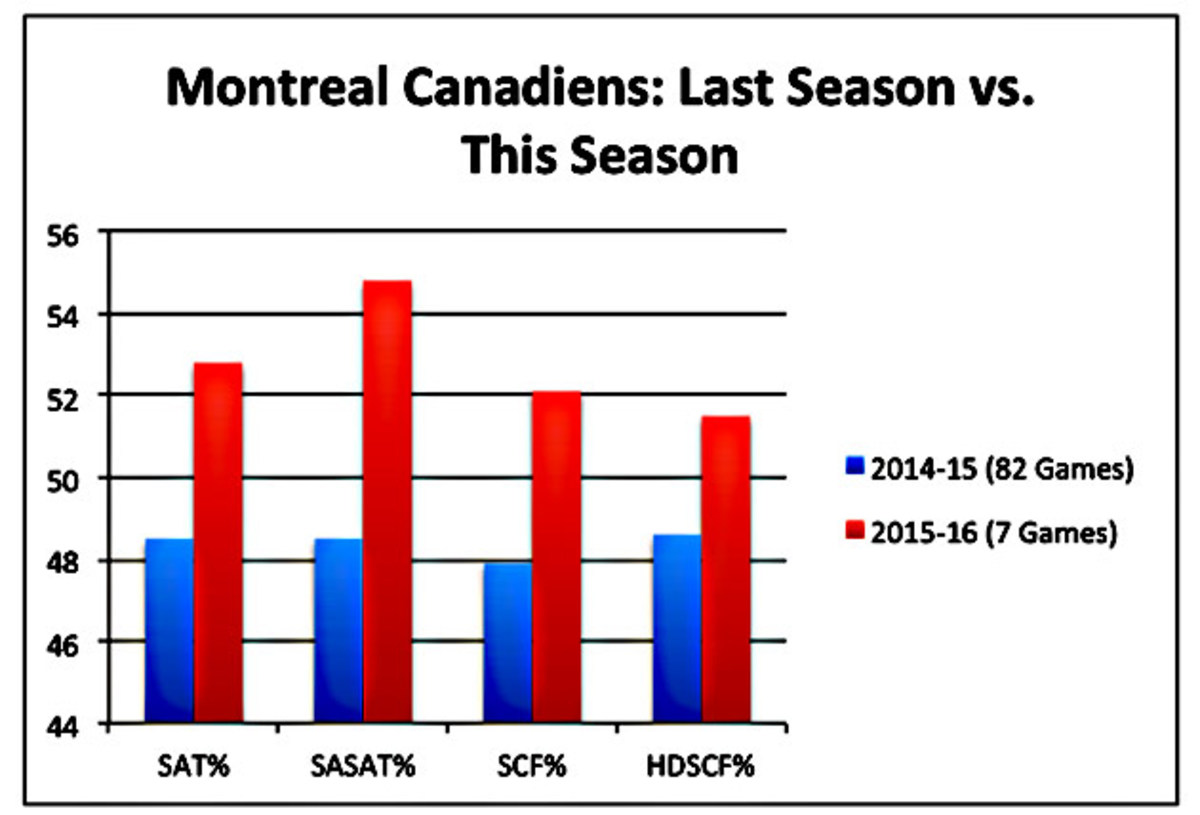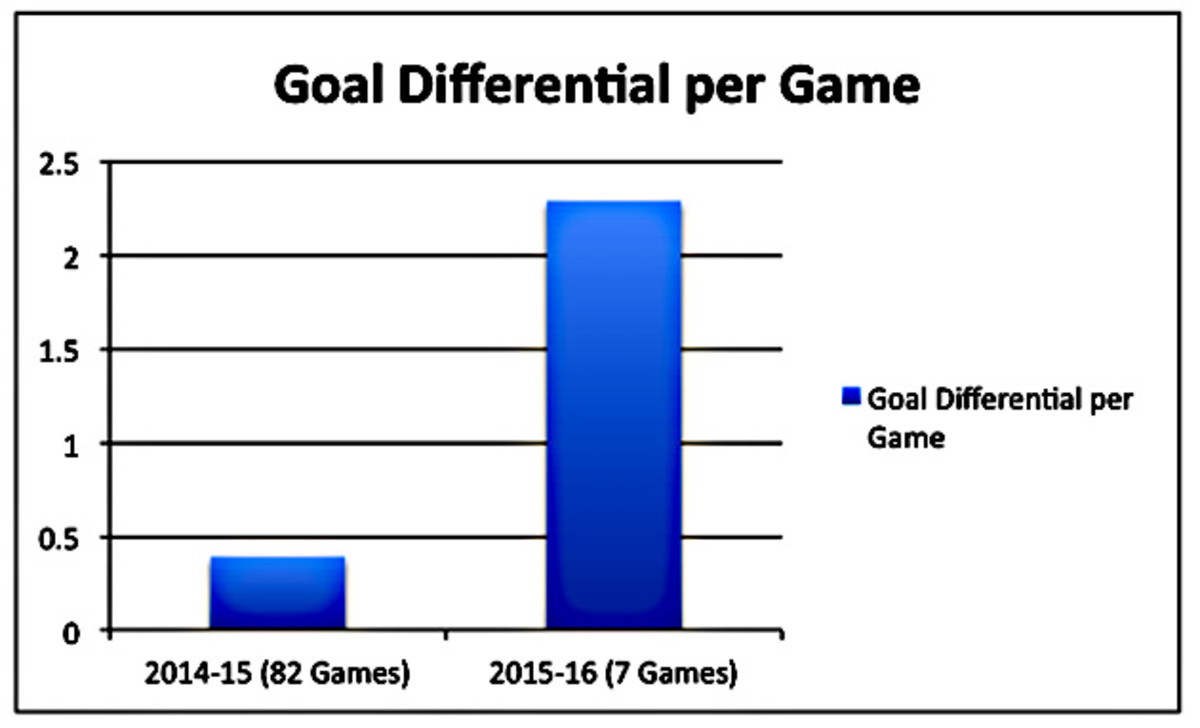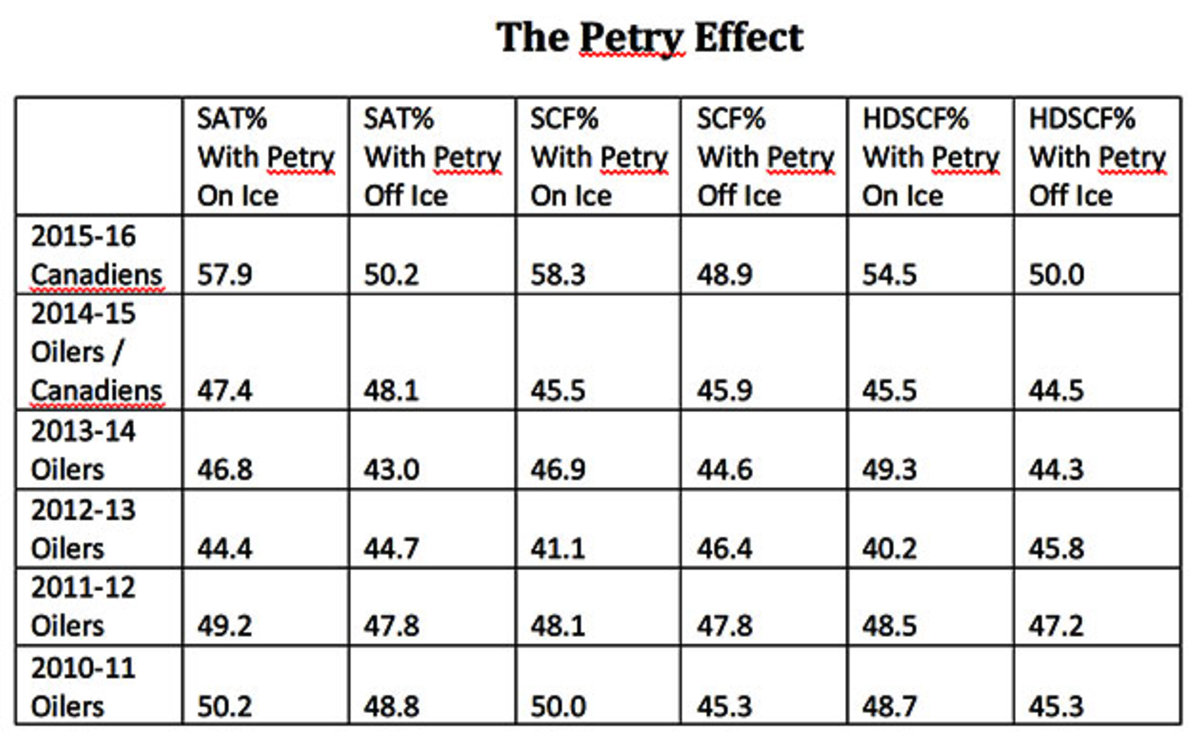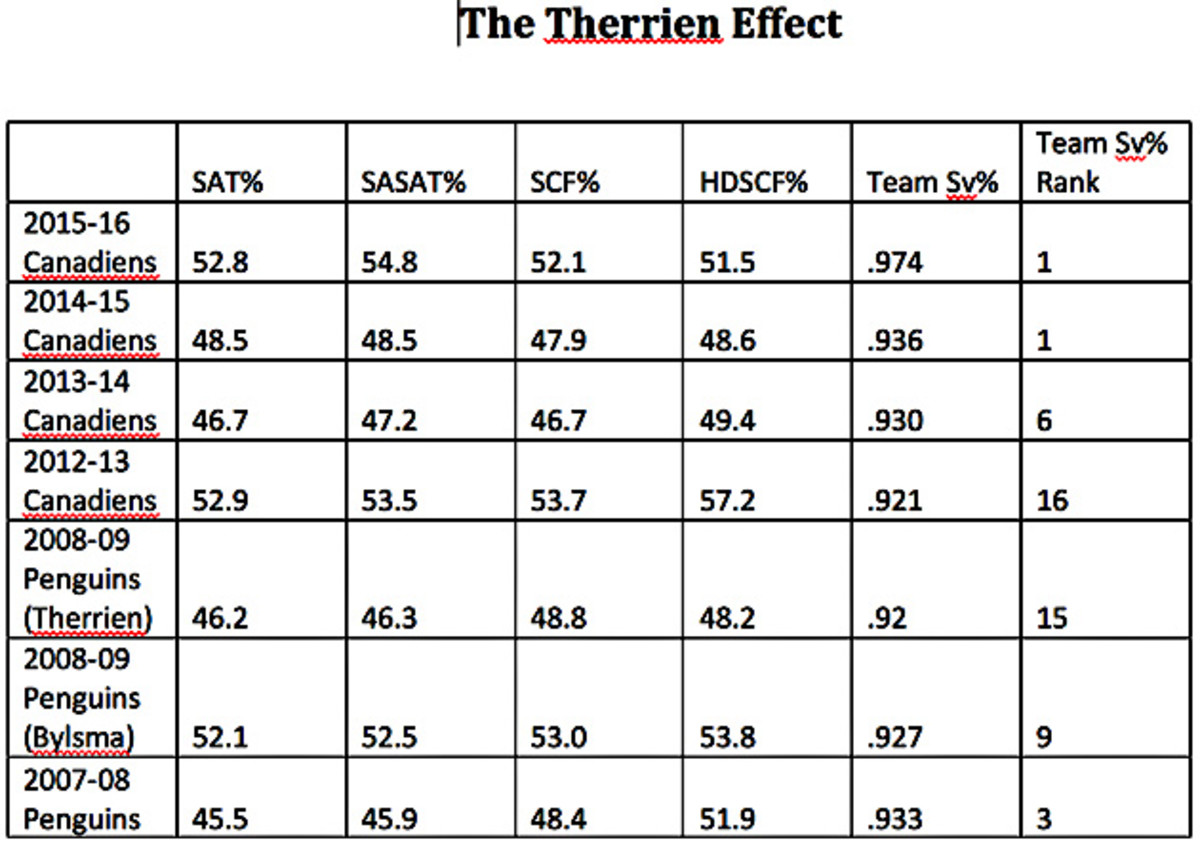Just how good are the 2015-16 Montreal Canadiens?

Talk to any hockey fan in Montreal (which means pretty much anyone in Montreal) and they’ll tell you their team is on the cusp of a championship.
They have goaltender Carey Price, who, unlike other false prophets with names like Jose Theodore and Cristobal Huet, seems poised to join the ranks of Jacques Plante, Ken Dryden and Patrick Roy in returning this storied franchise to its former glory.
They also made the Eastern Conference Finals in 2014 (which perhaps they would have won if Price hadn’t been injured) and were very competitive against a Tampa Bay team that advanced to the Stanley Cup Final last spring.
Through this lens, Montreal’s roaring start this season seems like a continuation of a trend that’s been bubbling the past couple of years.
Habs fans can be forgiven for spinning this narrative. But it just isn’t true.
Tuukka Rask a mess; Steven Stamkos trade rumor; Jack Eichel amazes
were a mediocre team that managed to win on the back of a very good goalie and a fair bit of luck.
During 5-on-5 play last season, Montreal posted a shot attempt percentage (SAT%) of 48.5%, which ranked 23rdoverall. To be fair, the Habs won a lot of games (50), so you might imagine “score effects” pushed their shot attempt numbers downward. After all, teams that are leading tend to get outshot.
Not in this case.
Despite all those wins, the team’s score-adjusted shot attempt percentage (SASAT%) was still 48.5% (22nd).
Of course, shot attempts only give us part of the story. After all, a few goals are surely worth more than lots of 60 footers that go wide.
As it turns out, the Canadiens didn’t just fail to generate shot attempts, they also failed to generate quality shot attempts—only 47.9% of their scoring chances (SCF%) vs. 52.1% for their opponents (24th), just a shade better than the “McEichel lottery” bridesmaid Arizona Coyotes (who passed on Mitch Marner in favor of Dylan Strome, who we projected to be a major bust—but we digress ...)
In any event, it was no accident that Montreal’s popgun offense yielded a top scorer with only 67 points.
The Habs may have posted an impressive 110 regular season points (2nd) in the standings, but their goal differential of +32 (6th) tells us that in the absence of some nice bounces that could have gone against them, they would have finished in the middle or perhaps even the bottom half of the playoff pool.
As analysts have noted repeatedly, winning despite poor underlying performance is unsustainable. Eventually the numbers catch up, and your team starts losing (more on that later).
Contrast that performance with this season, and it’s like you’re watching a completely different team.
In their first seven games the Canadiens have managed an SAT% of 52.8% (6th) and an SASAT% of 54.8% (4th).
When measured by scoring chances and high-danger scoring chances (HDSCF%), the numbers are equally solid at 52.1% (10th) and 51.5% (13th) respectively (all stats are courtesy of war-on-ice.com and puckon.net).


When changes like this happen, there are usually three possible causes: (1) the lineup; (2) the coach; and (3) luck.
The lineup
Montreal’s lineup has definitely improved, but by how much is debatable.
First there was the acquisition of defenseman Jeff Petry at the trade deadline. Despite logging more than 17.5 minutes of ice time at 5-on-5 for an Oilers squad that was rightly abused for its atrocious defense, Petry somehow managed to establish himself as a darling among the analytics crowd as well as Montreal fans who were impressed with his play down the stretch and in the playoffs.
And yet the Oilers, who continue to struggle to find NHL caliber defensemen, decided to let Petry go rather than negotiate a contract extension with him.
As the table below shows, Petry’s record in Edmonton was mixed: Some years the team was better with him on the ice, during others they were worse.
Nevertheless, Petry has become a beast this season, elevating the Habs’ impressive shot attempt percentage without him on the ice from 50.2% to 57.9% with him, their scoring chances from 48.9% to 58.3% and their high-danger scoring chances from 50.0% to 54.5%.

Up front, the Habs are basically the same team, but again there are some modest improvements.
Alex Galchenyuk, expected by many to have a breakout season, appears to be doing just that. His ice time has been dialed back from 13.4 minutes of 5-on-5 play per game to 11.6 minutes, but his points per 60 minutes are way up, from 1.8 to 3.0.
Tomas Fleischmann, a formerly decent goal scorer whose low shooting percentage (4.7% in 2013-14 and 6.9% last season) prevented him from cracking double digits the past two seasons, has been contributing offensively.
Rookie Anthony Duclair making Coyotes look really smart
Then there’s Alexander Semin, whose signing over the summer was greeted by a chorus of jeers. Despite his remarkable ability to inspire disdain in even (perhaps especially) his teams’ most die-hard fans, with the exception of his 2012-13 campaign (when he still managed a point per game), nearly every team that Semin has ever played for had a better SAT%, SCF% and HDSCF% with him on the ice than without.
So while actually watching Semin’s appalling gaffes and apparent lack of interest in making a consistent effort might tempt us to pull a Brian Burke and chuck the analytics in favor of the eyeball test, given where he’s being used (bottom six ice time with only 21.9% of his face-offs in the defensive zone), he’s starting to look like a bargain at $1.1 million.
Add it all up—Petry, Fleischmann, Semin, and Galchenyuk taking one more step toward stardom—and you’ve got a better lineup. But 7-0 with a goal differential of +16—only half of the +32 the Habs generated over 82 games last season?
We’re not buying the roster as the full story here.
The coach
Coaching the Canadiens is a strange job in that its first prerequisite excludes the overwhelming majority of qualified candidates.
While the other 29 teams try to scoop up the best coach, the Habs play a complicated game of politics and media relations that requires the hiring of a French speaker, ideally from Quebec. This does nothing for the team’s top scorers, who speak English, Russian, and Czech, or their world-class goalie, who’s also an Anglophone.
But hockey is the only big time sport in Quebec, and the Habs want a guy who can parler avec lesmédias. Which is what they get in Michel Therrien.
Unfortunately all objective data suggest Therrien’s a pretty bad coach—or at least was until about three weeks ago.
John Tortorella a dicey hire by the Blue Jackets, but he buys time
Price’s heroics allowed many fans to paint Therrien as some kind of “mad scientist” who understood just how far to push his All World Goalie without breaking him. In that view, the results speak for themselves and the rest is just meaningless nerd talk.
As it turns out, Therrien has been perfectly happy to get outshot and outchanced regardless of who’s between the pipes and regardless of how the guy’s doing. With the exception of his 2012-13 squad during the lockout shortened season, every single team that Therrien has coached since 2007 has had a worse than 50% SAT%.
And if you want to blame the players rather than the coach, you need only look at the 2008-09 Pittsburgh Penguins, who posted a SASAT% of 46.3% (26th) and HDSCF% of 48.2% (21st) in their first 57 games with Therrien as coach and then magically improved to 52.5% (7th) and 53.8% (3rd) respectively with Dan Bylsma at the helm for the remaining 25 before winning the Stanley Cup.
The table below gives the full picture of how Therrien’s teams and his goalies have fared.

The fact that Therrien’s playbook with Carey Price in his prime is essentially the same one he employed with Marc-André Fleury between the pipes tells you pretty much everything you need to know about the Habs’ coach.
Now it is possible that Therrien learned how to coach hockey during the off-season. It’s also possible he’s ceded control of the team to more capable hands and is content to occupy more of a ceremonial role. Kind of like Art Howe to Marc Bergevin’s Billy Beane.
But since it’s not easy to teach old dogs new tricks and coaches tend to have egos, neither explanation seems entirely satisfactory.
Luck
Which bring us to the last possibility, namely that the Habs have been lucky.
Luck is tossed around pretty liberally in analytics circles without actually being defined. Often it’s used as a proxy for “unsustainable.”
So, for example, when the Maple Leafs went into a tailspin at the end of last season, this came as no surprise to the analytics community, which repeatedly warned that a team couldn’t put up such horrendous possession numbers and expect to keep winning.
The same was said about the 2013-14 Colorado Avalanche, which finished third overall—again with horrid puck possession and some goaltending heroics from SemyonVarlamov, who had previously given no indication that he was that good. As we (and others) predicted, that story ended badly last season.
Calgary's GM puts Flames on notice as team melts down early
It’s still early in the season, but we also predicted a day of reckoning for the Calgary Flames, and despite all the “this team is different and can get outshot because…” screeds we received from southern Alberta hockey fans, they started with a 1-5 record.
As noted above, Montreal is a different story. While last season’s performance portended failure, the Habs are currently winning in a way that does look sustainable.
The question is: Has there been some underlying change in the Canadiens’ play or is this simply a team that’s having a good run and will revert to last season’s performance as the campaign wears on?
On balance, we think there’s a little of both at work here, meaning the Habs are a better team and they will also fall to earth.
All signs suggest that Tampa Bay will remain a tough divisional opponent and likely the gold standard in the East while Atlantic Division rivals such as Toronto and Buffalo shouldn’t be complete punching bags as the season wears on.
Meanwhile, in the Metropolitan, opponents like Pittsburgh, Washington, and the New York Islanders and Rangers should all be dominant. Philadelphia will push for a Wild Card berth.
If Therrien reverts to form and Price stumbles or suffers an injury, fans can look forward to a season's-end press conference in which the coach will be able to explain what went wrong in impeccable French while his top players nod in complete bewilderment.
More likely, Montreal finishes second in the Atlantic behind Tampa Bay and enters the playoffs with some hope but also some question marks.
The Department of Hockey Analytics employs advanced statistical methods and innovative approaches to better understand the game of hockey. Its three founders are Ian Cooper (@ian_doha), a lawyer, former player agent and Wharton Business School graduate; Dr. Phil Curry (@phil_doha), a professor of economics at the University of Waterloo; and IJay Palansky, a litigator at the law firm of Armstrong Teasdale, former high-stakes professional poker player, and Harvard Law School graduate. Visit us on line at www.depthockeyanalytics.com
